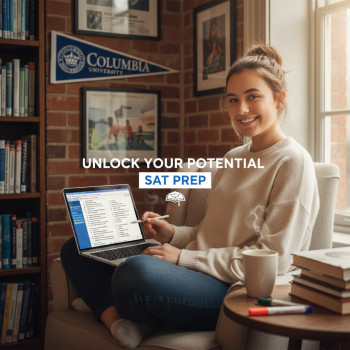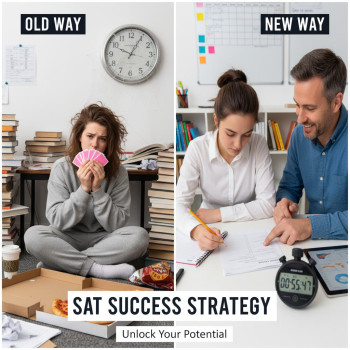Introduction: You Can Prep Well Without Breaking the Bank
If you’re a student or a parent staring at the college application timeline and wondering how to prepare for the Digital SAT without emptying the savings account, take a breath. The good news is that quality SAT preparation no longer requires a costly factory of classes, expensive books, or hours of commute to in-person sessions. The test has changed, tools have changed, and—best of all—so have the options for doing this affordably and effectively.
In this post you’ll find a practical roadmap: what to use (and why), how to schedule your study time, how to get targeted help when you need it, and real examples of cost-saving strategies that still deliver results. We’ll also highlight smart ways to get one-on-one guidance—such as Sparkl’s personalized tutoring features—without paying for more than you need.

Why the Digital SAT Changes the Game for Affordable Prep
The SAT moved to a digital format, and that shift brings real advantages for budget-savvy students. Digital testing emphasizes adaptive sections and testing apps that you can practice with at home. College Board now offers a suite of free, official practice tools that simulate the digital experience—so you can get comfortable with the platform without paying for a course that teaches you to click and scroll.
Here’s what this means for saving money:
- Official practice tests are available in an adaptive digital format—practice is realistic and free.
- Personalized study paths are easier to create because you can quickly identify strengths and weaknesses from real practice tests and then target them.
- Low-cost or free resources like Khan Academy (with integrated official content) provide structured study that’s nearly as powerful as many paid programs—when used well.
Start with the Free, Official Stuff (Use It First, Use It Well)
Before you spend money on anything, do this: take a timed, full-length practice test on the same digital platform the SAT uses. This gives you two huge benefits:
- A realistic baseline score to measure improvement.
- A clear view of which question types and timing issues are the real drains on your score.
Pair this diagnostic with the official practice tools and explanations—you’ll get high-quality content that’s aligned to the test itself. That alignment is the single biggest factor in efficient studying: practice that reflects the real test helps you close the gap faster, which saves time and money.
Which official resources to use first
- Official adaptive practice tests in the Bluebook environment—simulate the real test format and timing.
- Practice question explanations and scoring guides—understand not just which answers are right but why.
- Khan Academy’s Official SAT Practice—personalized practice plans mapped to your diagnostic results.
Build a Lean, Effective Study Plan
Money is time and time is money. A focused study plan avoids wasted hours and unnecessary purchases. Here’s a simple, low-cost structure that works for most students:
- Week 1: Diagnostic test + error analysis (use only official practice tests).
- Weeks 2–6: Targeted skill blocks—work in 2–3 week cycles on weakest areas.
- Weeks 7–10: Full-length timed practice every 7–10 days; review errors deeply.
- Final 2 weeks: Light review, timing drills, and test-day logistics practice.
Focus on quality of practice: deliberate practice beats hours of passive review. One really focused 90-minute study session fixing one recurring weakness is better than three unfocused two-hour sessions. Keep a short log: what you practiced, what errors repeated, and what improved.
How to Use Low-Cost Tutoring Efficiently
One-on-one tutoring can be a game-changer, but full-time private tutoring for months can be expensive. The trick is to use tutoring as a targeted amplifier, not as the core of your prep.
Here are smart, money-saving ways to use tutoring:
- Micro-sessions: Book shorter, focused sessions to fix a specific weakness—30 to 60 minutes targeted on one topic. These are cheaper and often more impactful than open-ended weekly sessions.
- Score-building blocks: Use a tutor for strategy sessions—timing strategies, passage mapping, and test-day routines—rather than basic content you can learn from free materials.
- Tutor-guided practice review: After a practice test, ask a tutor to review the most damaging 10–15 questions with you rather than the whole test.
If you choose a tutoring provider, look for flexibility in session length and the ability to get progress reports. An efficient tutor makes each minute count.
For families considering a blended approach, Sparkl’s personalized tutoring model can be an excellent fit: it blends AI-driven insights, 1-on-1 guidance, and tailored study plans so you invest only in what the student truly needs. That means fewer wasted sessions and a clearer route to score improvement.
Free and Low-Cost Resources That Deliver Real Value
To make a meaningful dent in scores without spending a lot, combine these resources strategically.
- Official digital practice tests (first and foremost).
- Khan Academy Official SAT Practice—free, personalized, and aligned to actual SAT content.
- School resources—teachers, SAT School Day practice, and library materials can be surprisingly helpful at no cost.
- Peer study groups—organized study groups can be highly effective and low-cost when structured with goals and accountability.
How to combine them weekly
- 3 days: targeted skill practice (30–50 questions from Khan Academy tailored list).
- 1 day: timed section practice (Bluebook mini-test or official section practice).
- 1 day: review and reflection (review errors deeply, update study log).
- Weekend: 1–2 hours group review or short tutor session if needed.
When to Spend Money—And Where It Gives the Best Return
Not all spending is wasteful. The most cost-effective investments are the ones that multiply your gains quickly. Consider spending selectively on:
- Targeted tutoring sessions after a diagnostic test to address stubborn weaknesses.
- One or two proctored full-length tests if you need simulated conditions and accurate timing feedback.
- High-quality practice materials for niche areas (for example, advanced grammar work or complex math topics).
Spend only when you can’t achieve the same result with high-quality free resources and smart practice. For many students, paying for a few guided sessions—especially with tutors who create short-term, laser-focused plans—yields more score improvement per dollar than paying for months of generalized instruction.
Sample Budget Plans: Minimal, Balanced, and Strategic
Below are three sample budgets to show how different families might allocate funds depending on needs and goals.
| Plan | Core Components | Estimated Cost Range | Best For |
|---|---|---|---|
| Minimal | Official digital practice tests, Khan Academy, school resources | $0–$50 (printing, optional supplies) | Self-motivated students with 8–12 weeks to study |
| Balanced | Official practice + Khan Academy + 4–6 micro tutor sessions | $150–$600 | Students needing targeted help in 1–2 areas |
| Strategic | Official practice + Khan Academy + 8–12 tutor sessions + 1 proctored practice test | $600–$1,500 | Students aiming for a significant score jump in 2–3 months |
These are estimates; the exact costs depend on tutor rates and whether sessions are in-person or online. The key is: match spending to your most impactful needs.
Make Practice Count: Techniques That Multiply Returns
Saving money is about maximizing return on every hour you study. Try these high-impact techniques.
- Active error analysis: After each practice session, categorize mistakes (careless, concept gap, timing) and fix the underlying cause—not just the question.
- Spaced repetition for vocabulary and grammar rules: short, regular reviews beat occasional marathon sessions.
- Backward practice for math: start by reading the solution and then work backward to understand how the correct approach is constructed.
- Timed chunking: practice completing smaller timed sections (20–30 minute chunks) to build stamina and pacing without needing a full-length test every time.
Example: How one hour of smart practice beats three hours of unfocused review
Take a student who often runs out of time on Math Calculator sections. Instead of doing three random math problem sets, a more effective hour looks like this:
- 10 minutes: quick warm-up with 6–8 moderate problems under timed conditions.
- 35 minutes: focused practice on problem types that cause the most timing pressure (e.g., multi-step algebra). Use official practice questions only.
- 15 minutes: error log and one targeted short drill to correct the specific misconception found.
This concentrated approach addresses the root cause quickly, reducing the need for many more hours of general practice.
Group Study and Peer Tutoring: Free Help That Works—If It’s Structured
A well-run study group is one of the best free resources. To keep it effective and not turn it into a social hour, set ground rules:
- Have a clear agenda every meeting (e.g., timing drills, two problems to solve, one concept review).
- Rotate roles: one student times, one reviews solutions, one brings a mini-lesson.
- Use official practice questions as the backbone of the session so the work is directly relevant to the test.
Peer teaching is powerful: explaining a concept teaches it twice—once to the student and once to the explainer. If your school offers peer tutoring, take advantage of it—the tutors often know what local colleges expect and can share practical tips.
Test Day Logistics You Shouldn’t Forget
Small logistical errors can cost points. Practicing the testing environment is free and smart.
- Download and practice with the same testing app (Bluebook) so you’re comfortable with navigation, tools, and marking questions.
- Practice with the same device (laptop/tablet) you’ll use on test day if possible.
- Run a mock test under real conditions once every 2–3 weeks—same start time, breaks, and minimal distractions.
- Plan test-day logistics early: travel time, what to bring, and how to handle tech issues.
Scholarships, Fee Waivers, and Cost-Saving Administrative Tips
Beyond prep, don’t forget there are ways to reduce testing costs directly. Some families qualify for fee waivers for registration, and many schools offer school-day testing with no extra fee. Investigate these options early so you don’t pay unnecessarily.
Also, colleges increasingly accept digital score submissions and sometimes allow self-reporting or optional submission policies. That administrative flexibility can also reduce the need for multiple test dates (and the cost that goes with them).
When Personalized Tutoring Makes the Biggest Difference
There are three moments where spending on personalized tutoring typically delivers outsized value:
- When you’ve plateaued after consistent practice and need expert analysis to break through.
- When an upcoming test date requires rapid gains in a short timeframe.
- When specific college admissions goals require a precise target score.
In those cases, look for tutoring that combines individual attention with measured progress tracking. Sparkl’s approach—pairing 1-on-1 guidance with tailored study plans and AI-driven insights—can reduce wasted sessions and focus effort where it matters most, helping students hit score targets faster and often with fewer hours than traditional approaches.
Real-World Example: How Two Students Saved Money and Increased Scores
Student A (Self-driven, limited budget): Started with an official diagnostic, used Khan Academy for a 12-week plan, joined a weekly school study group, and scheduled one micro-tutor session per month focused on timing. Result: +90 point improvement, under $50 spent.
Student B (Targeted intervention): Took a diagnostic, used official tests to pinpoint a stubborn math concept gap, bought four 45-minute targeted tutoring sessions to fix the gap, and practiced with the Bluebook app weekly. Result: +140 point improvement, total cost around $500—far less than a full-length prep course and with direct impact.
Common Mistakes That Waste Money (and How to Avoid Them)
- Buying every prep book: Instead, choose one comprehensive resource and supplement with free official practice.
- Random tutoring: Avoid packages without clear goals. Buy sessions tied to milestones (diagnostic, mid-point check, pre-test review).
- Over-testing: Multiple test dates add up. Aim for smart preparation so you need fewer tries.
Checklist: A Cost-Conscious Prep Plan You Can Start Today
- Take an official digital practice test to set your baseline.
- Create a 10–12 week study schedule focused on weaknesses.
- Use Khan Academy plus Bluebook adaptive practice as primary study tools.
- Join or form a structured study group for weekly accountability.
- Buy micro-tutoring sessions only for targeted problem areas or strategy coaching.
- Run full-length digital simulations every 1–2 weeks in the last month.
- Plan test day logistics using mock runs with the Bluebook app and your device.
- Check eligibility for fee waivers or school-day testing to reduce administrative costs.

Final Thoughts: Smart Choices Beat Big Budgets
High-quality SAT prep is about strategy, not spending. Start with official digital practice to build an evidence-based plan. Use focused, deliberate study sessions. Reserve paid help for places where it moves the needle—micro tutoring, targeted concept repair, and timed practice that mimics test conditions. That combination will help you save money and improve scores more efficiently than a long, expensive prep program.
If you want a guided, cost-effective route that blends personalization with efficiency, consider tutoring options that offer tailored study plans, measurable progress tracking, and flexible session lengths. Approaches like Sparkl’s—combining 1-on-1 guidance, expert tutors, and AI-driven insights—can help ensure each dollar spent directly contributes to score gains.
Keep the focus on consistent practice, smart review, and efficient use of paid resources. With the right plan and a few well-chosen investments, you’ll be surprised at how far your prep budget can go.
Ready to Start?
Take a deep breath and begin with the diagnostic test this weekend. Build your plan from your real results—then choose the targeted supports that will close the gaps. With focused effort and smart spending, you’ll be ready for the Digital SAT and for the next step in your college application journey.














No Comments
Leave a comment Cancel